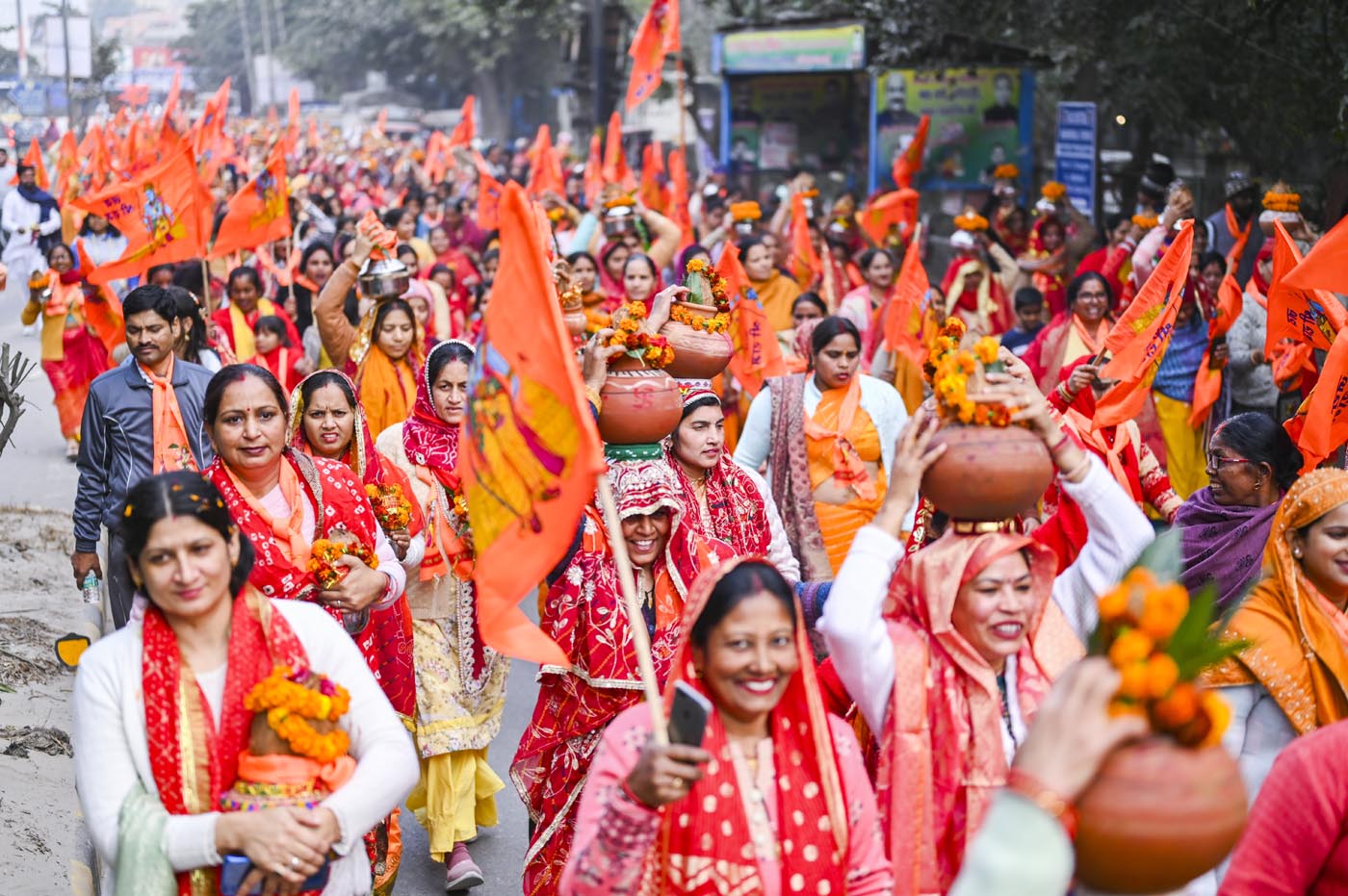Let the Pilgrimages Begin!
In the sacred land where flows the Sarayu River, Ram Lala has made His divine return after five centuries of exile to His birthplace on the sacred soil of Uttar Pradesh in India. His newly inaugurated grand temple is the summit of devotion, engineering and national pride. It was inaugurated by India’s Prime Minister Narendra Modi on January 22, 2024, ushering in a new era of spiritual awakening in Bharat.
It was early morning in Kathmandu when I received an email from Hinduism Today inviting me to chronicle the splendor of Ram Mandir. I exclaimed, “Jai Shri Ram.” With hearts overflowing with devotion, fellow journalist Rajeev Gurung and I embarked on this sacred journey by plane on February 13.
By Nikki Thapa, Nepal
The captain’s voice resonates through the cabin, heralding our plane’s imminent descent into the just-opened Maharishi Valmiki Airport in Ayodhya, and the ambient air vibrates with chants of “Jai Shri Ram, Jai Jai Shri Ram.” This vibrant mantra will be our constant companion during our five-day pilgrimage to Lord Ram’s Treta Yuga birthplace.
We arrive at the partially constructed temple under the cloak of evening; but it is not too late, since the generous darshan hours extend to 10pm. Immersing ourselves in the throng of devotees from diverse backgrounds, we navigate through crowds busily taking selfies, posting live on social media, or video calling with friends and family back home who couldn’t join them this time.
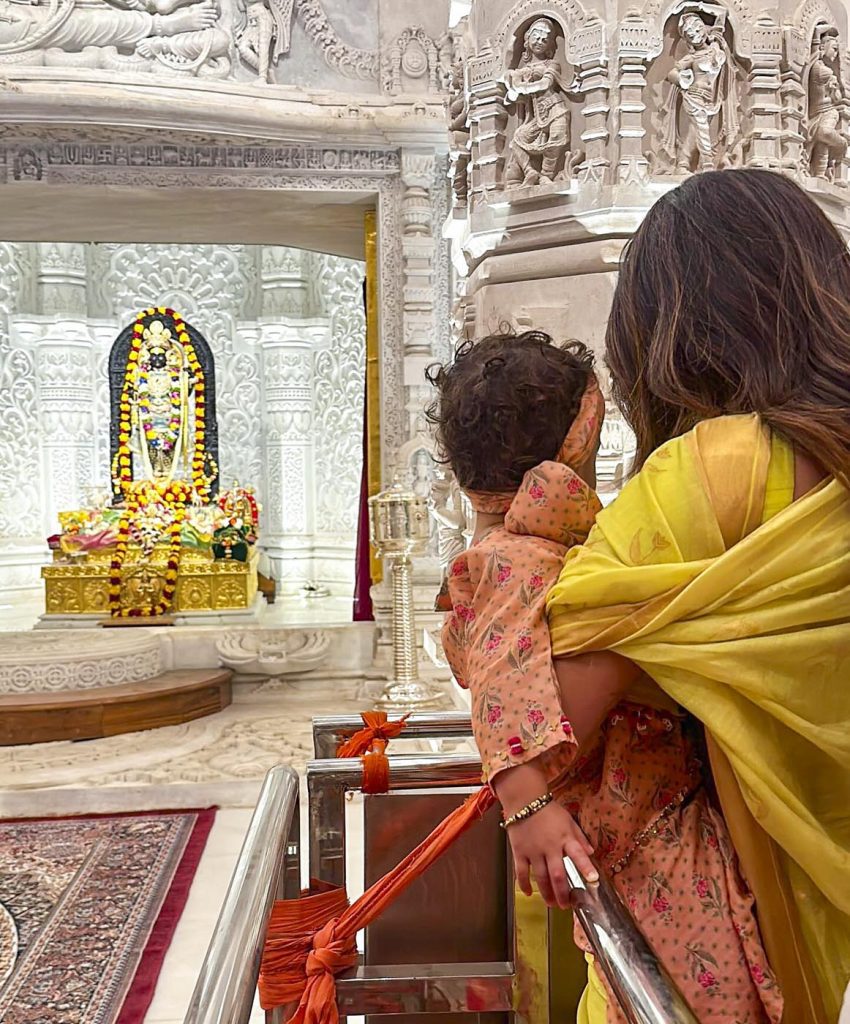

At the pilgrims’ entrance, we deposit our shoes at booths arranged alphabetically. Volunteers efficiently deal with the massive influx of pilgrims, accepting shoes from one side of the booth and returning from the other side. A similar system is used at the cloakrooms, where we deposit our belongings—bags, mobile phones, cameras, watches, snacks, and even flowers and prasad—before joining the parikrama route to the temple.
Photography inside the temple premises is strictly prohibited after this entrance. The ritual circumambulation takes us about forty minutes, starting and ending at the pilgrims’ entrance. All the while, the air resounds with jubilant and harmonious chants of “Jai Shri Ram” as we make the procession towards the sanctum for darshan of Ram Lala.
As it is already dark, my ability to appreciate the exteriors, designs and motifs of the temple is limited. However, I note the newly installed statues of a pair of elephants, lions, Garuda, and Hanuman on plinths flanking the temple’s entrance stairway to the small and newly completed Chowki Samran. This is the first of five progressively larger ornately roofed halls leading up to the as yet unfinished main towering shikhar (pinnacle) over the sanctum sanctorum or garbha griha (“womb chamber”), which houses the main Deity.
A serene granite murti of Lord Ram presides at the heart of the shimmering garbha griha. To our right is the Kirtan Mandap, Hall of Music, resonating at the moment with soul-stirring Carnatic kirtana, devotional songs composed by South Indian classical musician Shri Tyagaraja (1767-1847), offered by the musicians of Kerala. This is part of “Shri Ram Raag Seva,” a magnificent 45-day festival of music initiated on January 26, 2024, five days after the historic inauguration day.
The Child Rama’s New Home
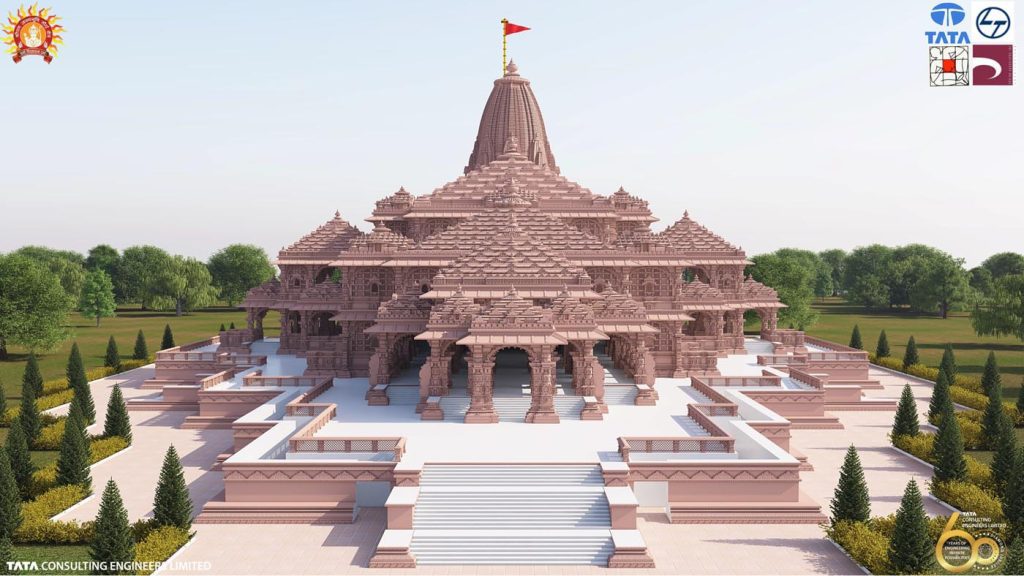

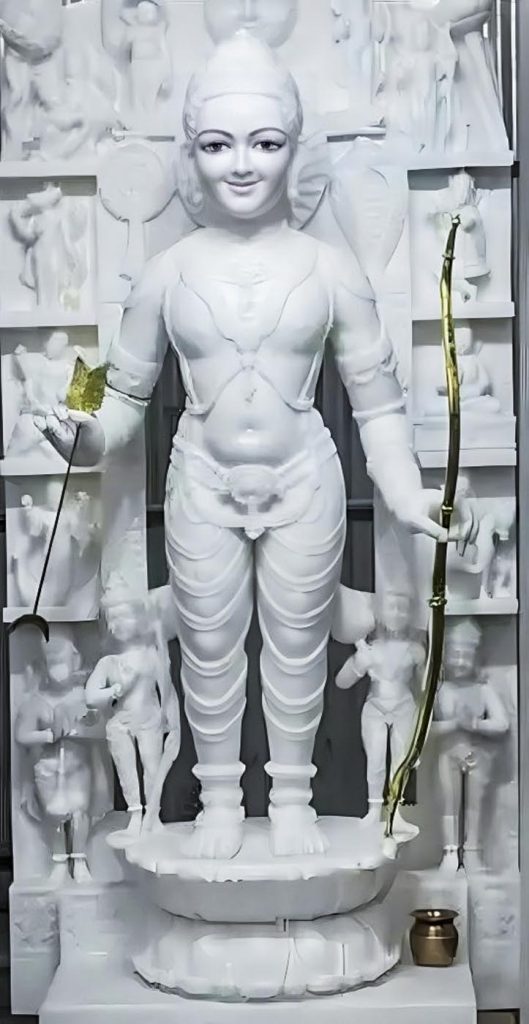

In the moment, as I behold the Deity from afar (approximately 30 feet), the surrounding chants seem to fade into the distant murmur, leaving me to only hear myself chanting prayers for my family. From that distance, I try to discern whether the visage of Ram Lala bears any resemblance to the reclining Vishnu of Budhanilkantha Temple in Kathmandu, as my mother believes. To my eyes, it indeed does.
Tens of Thousands of Devotees Arrive Daily


According to Dinesh Chandra, patron of Vishwa Hindu Parishad, the temple was only 10% ready at the time of the inauguration, with the remaining 90% of construction anticipated to extend over the coming year. We appreciate his optimism, but it looks like much more than a year’s work lies ahead for the temple. Three towering cranes, removed for the dedication, are back in place now. And what to say of the rest of the 68-acre site! But his determination is evident. “Our years of tapas (austerity) have borne fruit. Our Hindu brothers were chased, beaten and arrested for it, but we are witnessing this historic moment now.”
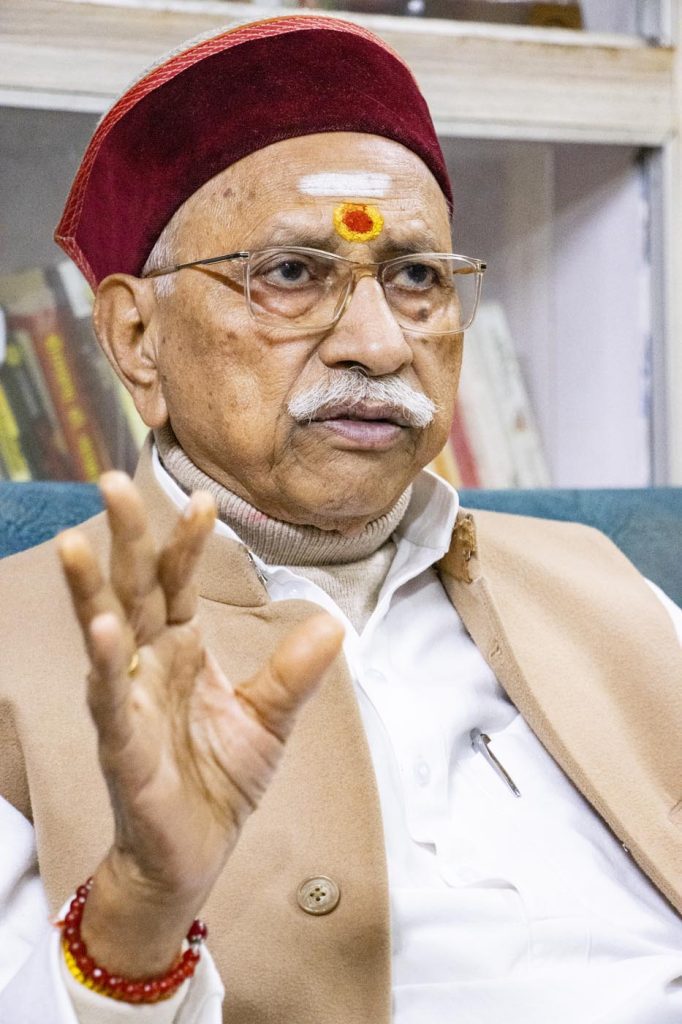

In the Ramcharit Manas, Saint Tulsidas says there is no suffering and distress in Ram Rajya, literally “under the reign of Lord Rama.” That society is perfectly based on virtue, morality and justice. The construction of Ram Mandir, according to Dinesh, is the first step towards the Ram Rajya.
Now let us begin our tale of this magnificent creation with the story of the central Deity, Lord Rama as a five-year-old boy.
Murti of Shri Ram Lala
The murti of Ram Lala is in a standing posture, a masterful creation 51 inches tall weighing 3,000 pounds. Sculpted from a single block of black granite, it arrived at its eternal abode in Ayodhya just five days before the consecration ceremony, amid fervent prayers and rituals.
This murti was crafted by the skilled hands of Mysuru-based sculptor Arun Yogiraj, who has a family background of five generations of famous sculptors. It captures His innocent divinity and kingly aura with unparalleled grace. He holds a golden bow and arrow, signaling His readiness to vanquish adharma, unrighteousness. He has lotus eyes, as described by scriptures, allowing devotees to gaze into the depth of compassion and wisdom. Adorned with lavish gold and jewels, the murti reflects the royal lineage of Lord Ram, embodying His sovereignty and divine power.
Pilgrims’ Darshan Route
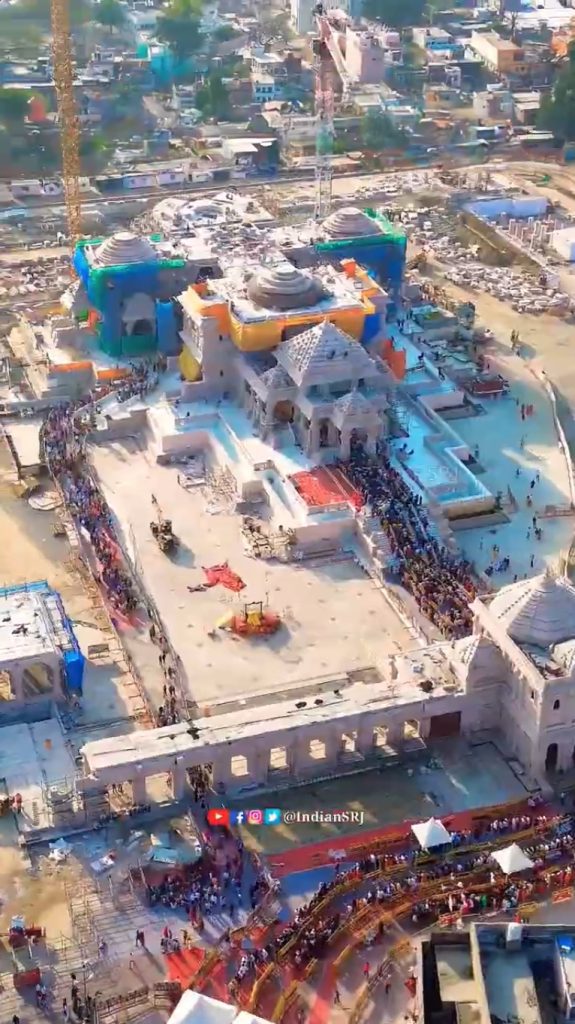

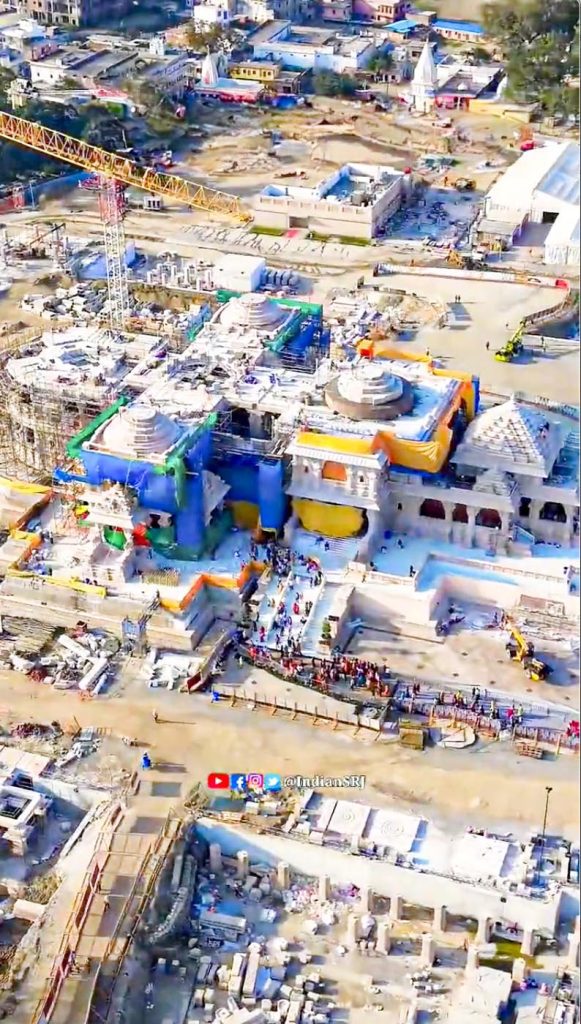

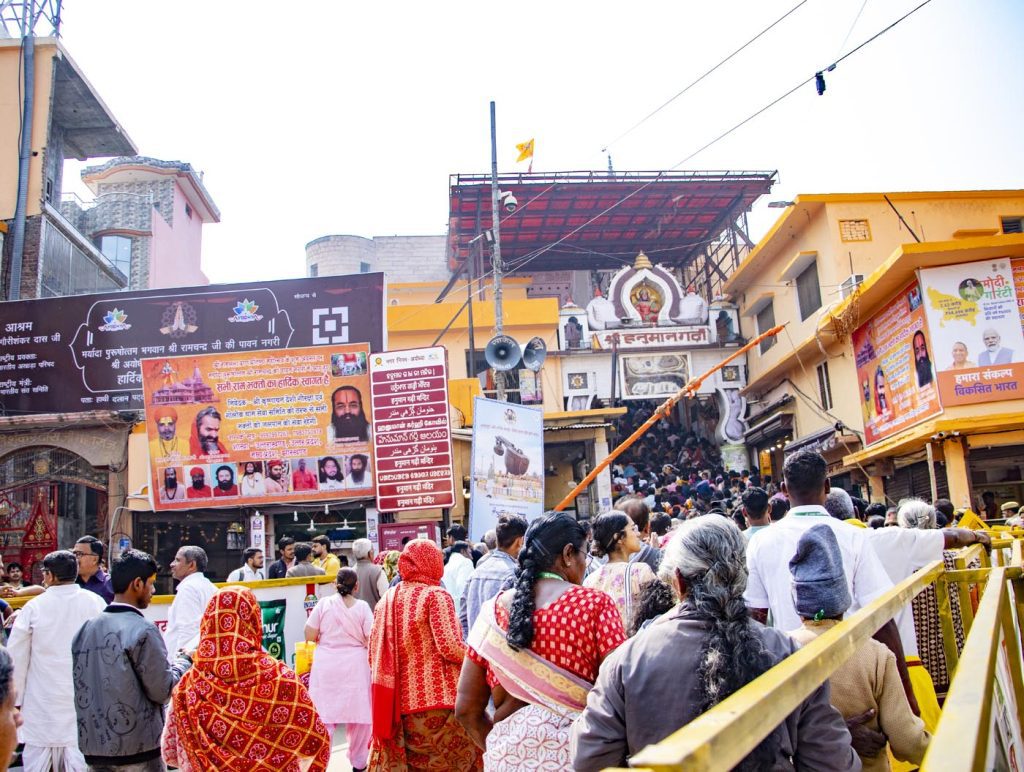

The ancient original murti of Ram, which had been housed in a tent for an extended period, now stands positioned below the newly enshrined one. This statue measures just five to six inches in height, making it inconspicuous from a distance of 30 feet. Hence the decision was made to opt for a larger statue, ensuring its visibility and prominence in the sacred space.
Because of its youthful innocence, divine presence and royal demeanor, the temple trust authorities selected Arun’s creation unanimously over two other murtis by equally skilled carvers from Rajasthan and Orissa. The other two, a black stone statue carved by sculptor Ganesh Bhatt and a white marble one sculpted by Satyanarayan Pandey, await their final placement within the temple complex.
The Grand Plan Is Quickly Manifesting Itself
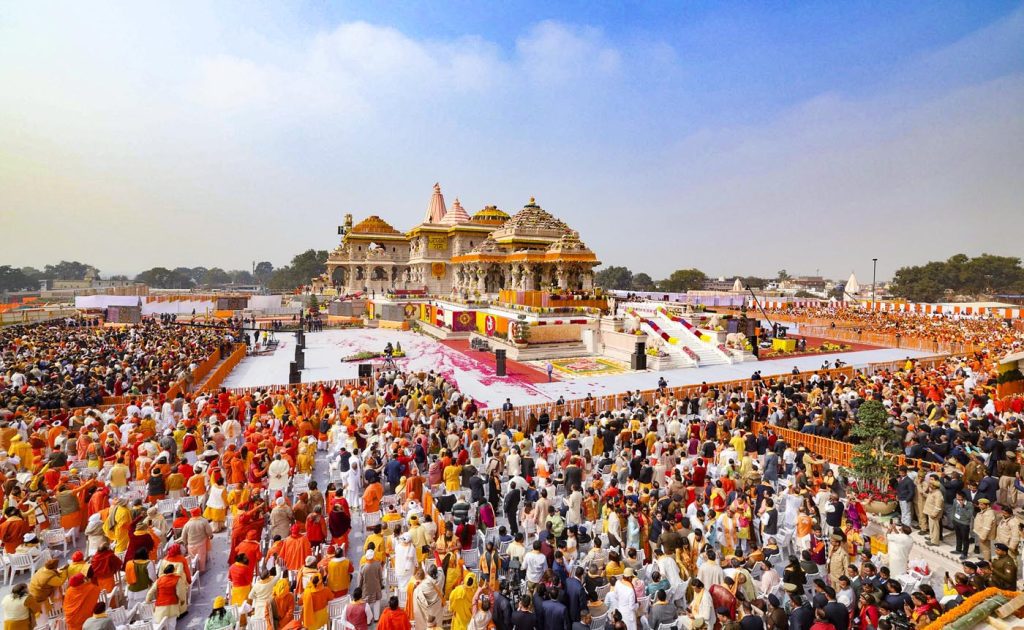

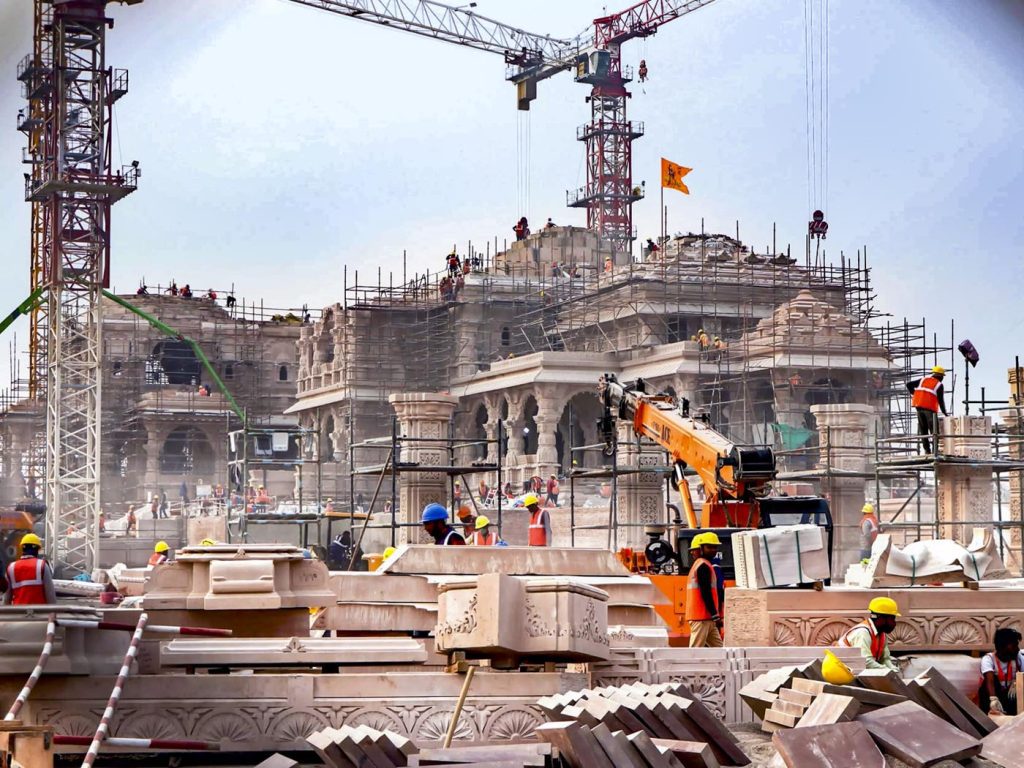

Arun had procured the three-billion-year-old rock for chiseling the Ram Lala statue from Ramdas H, a venerable 70-year-old Dalit farmer residing in the Gujjegowdanapura village near Mysuru in Karnataka State. The stone is Krishna Shila or black schist, with a dark blue tint—very much as Krishna is often depicted. Overflowing with joy, Ramdas deemed it a blessed occurrence that a stone block from his land became a chosen material for the revered murti. According to him, Yogiraj selected additional stones from his property to sculpt the temple’s murtis of Bharat, Lakshman and Shatrughna. In a triumphant gesture, Ramdas declared his intent to donate one acre of land to facilitate the construction of the Ram Temple in Mysuru. Surprisingly, he was not invited to the events of January 22.
“Now, talking about the murti of Shri Ram Lala,” explains Durga Prasad Gautam, one of the mukhya acharyas (main priests) of the Ram Mandir, “we don’t have the tradition of making black granite murtis in North of India, only white marble, but it appears to have been Shri Ram Lala’s wish that He manifest in black granite, so that is how He came in the form of a five-year-old boy.”
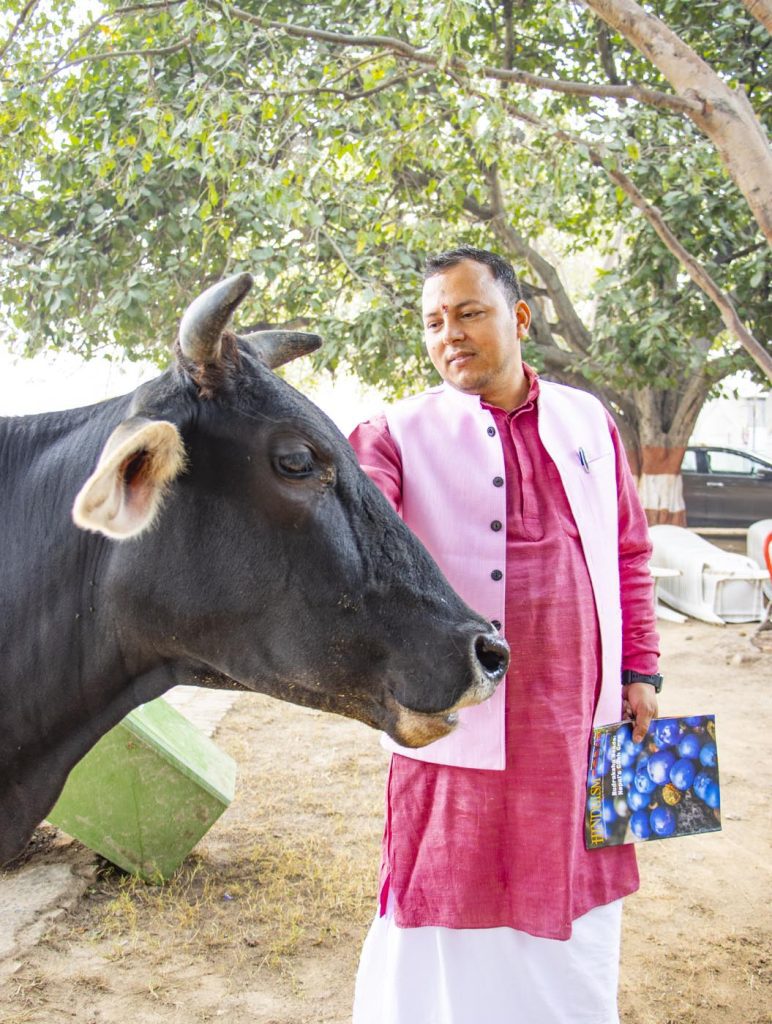

Rajkumar Temabre, a pilgrim from Gondia district, Maharashtra, leading a group of 150 pilgrims from Vidarbha, describes the darshan as an unforgettable moment of his life: “It is a dream come true for all of us, all the sacrifices that my ancestors made for 500 years, the constant struggles and our brothers who gave up their lives for Ram Mandir, all these dreams have now come true.”
The Ongoing Construction
In recreating the original temple, there was little to go on from the past. The archeological excavations following the destruction of the masjid definitely indicated the prior existence of a temple about 200 feet long in the north-south direction, but there was little information about its construction.
The new Ram Janmabhoomi temple, being built in a traditional Nagara style, spans over 380 feet in length and 250 feet in width, and will rise to a majestic height of 161 feet. A compound wall or parkota encloses the immediate seven-acre area. At the four inside corners of the wall will be mandirs dedicated to Surya Deva, Devi Bhagwati, Ganesha and Shiva. Two more, to Annapurna and Hanuman, will be located along the wall.
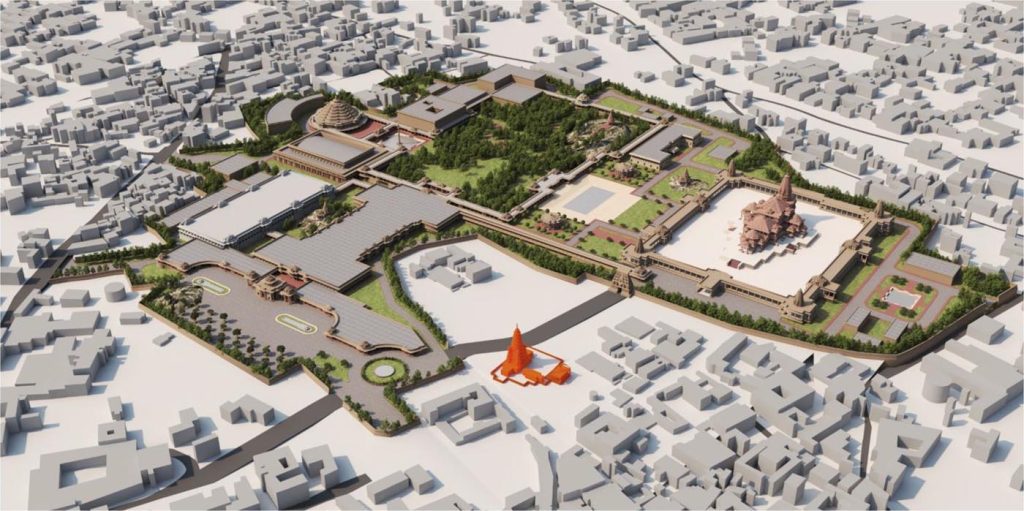

Looking at the 3D view of the architectural layout prepared by Tata Consulting Engineers, the temple is a three-story monument with each floor measuring 20 feet high. The ground floor is supported by 160 pillars, the first floor by 132 and the second by 74. There are 44 doors in total. The temple complex is accessed on the eastern side by ascending 32 stairs to the main temple platform and then through the Chowki Samran, the temple’s entrance tower. This then leads to the five halls, one each for dance, theater, assembly, prayer and songs. The 400-square-foot sanctum sanctorum, at the western end, is topped by the 161-foot-tall shikhara tower.
As Dinesh Chandra mentioned, the work on the temple is yet to be accomplished. As of February 2024, most of the work has been completed on the entry point on the eastern outer wall and the temple’s five halls, but only the central sanctum chamber is fully finished. He said the temple was only 10% finished as of now. Temporary structures resembling the final towers were installed for the dedication, but these have since been removed and the giant cranes set up again beside the temple. It is a vast construction zone. Amidst this progressive chaos, the finished pillars and walls that have risen so far are adorned with intricately sculpted depictions of Hindu Deities and celestial angels of Lord Indra.
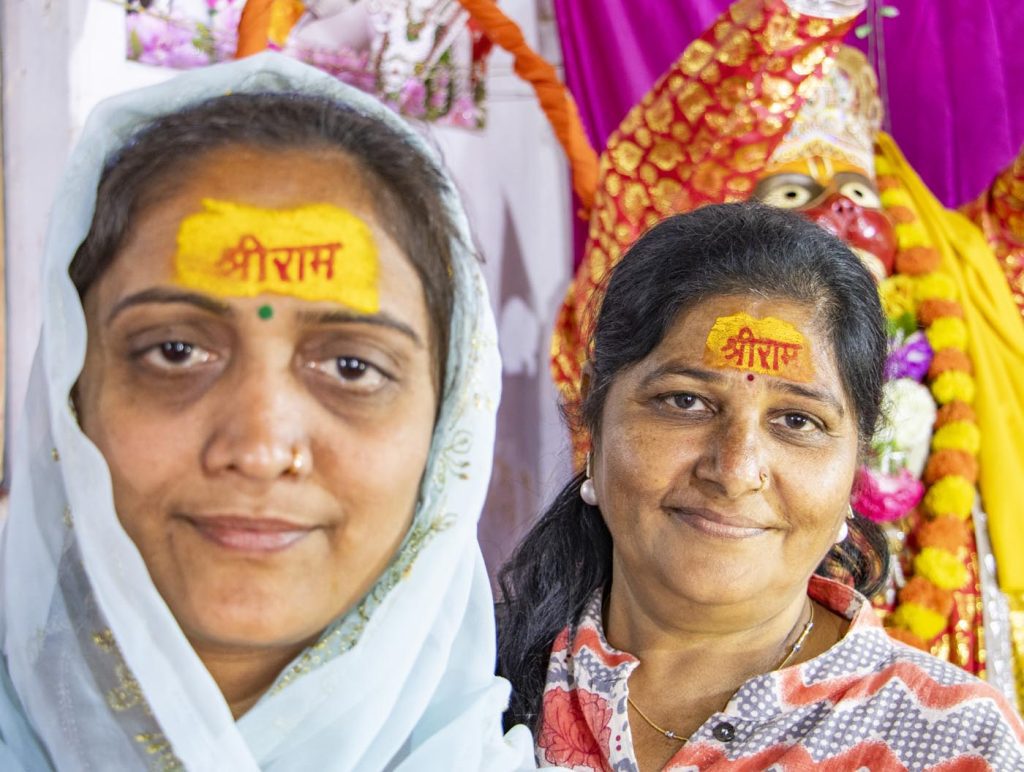

The laborers in their yellow and blue helmets are a common sight—navigating the scaffolding with expertise, skillfully carving motifs into sandstone pillars, slicing through stone slabs and stacking them, maneuvering cranes to erect roof structures, and so on. This bustling construction site goes on behind the makeshift boundary of advertisement billboards, a physical barrier wall between the construction site and the carpeted walkway path used by pilgrims exiting the temple after darshan through the southern door. The ecstatic devotees, immersed in post-darshan bliss, seem to traverse the disorderly construction site with ease, largely unconcerned with the ongoing construction and its optimistic timeline.
The historic event that has unfolded with the construction of the temple in the sacred city of Ayodhya is a testament to the fusion of ancient tradition with modern science to ensure the temple’s longevity and significance for generations to come. Top Indian scientists have been integral to the construction since its inception. The temple is designed to withstand a 2,500-year-return-period earthquake, as rigorously tested and confirmed by the Central Building Research Institute.
The foundation, constructed with a 46-foot-thick layer of roller-compacted concrete, stabilizes the temple in an area of otherwise unstable sandy ground beside the Sarayu River. Tens of thousands of bricks inscribed with “Shri Ram,” prepared by thousands of devotees, were ceremonially included in the foundation. The temple itself is made from natural stone and not bricks.
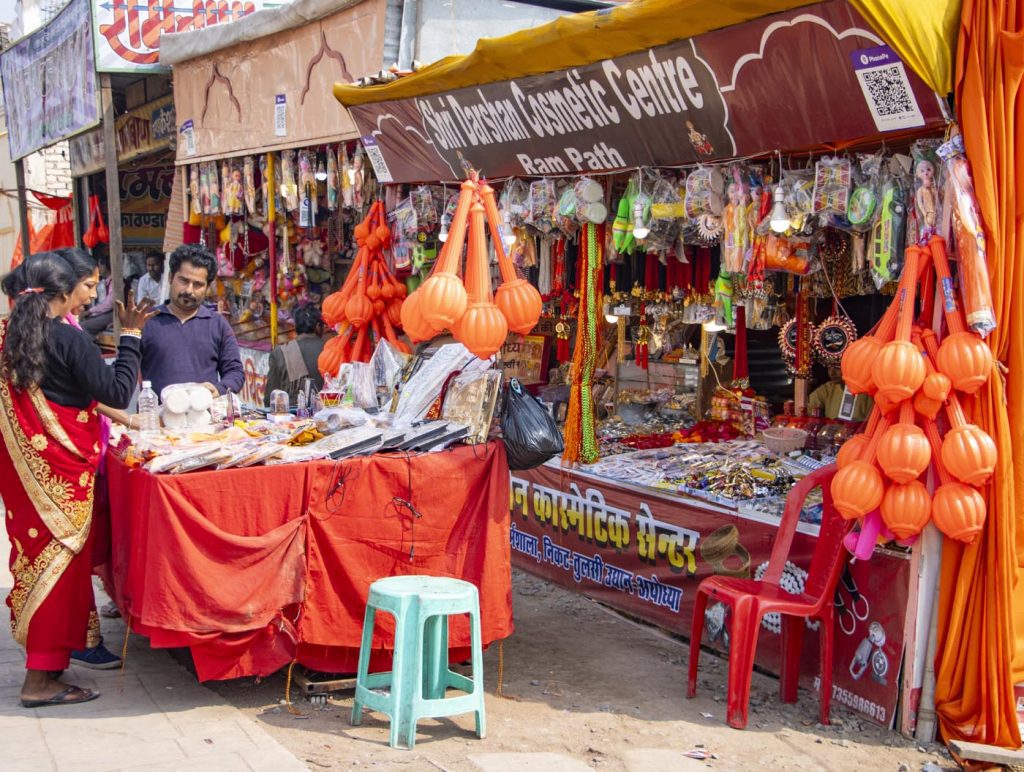

The construction also eschews the use of steel or iron. Instead, it relies on Bansi Paharpur pink sandstone, granite and mirzapur stone to ensure durability and adherence to traditional practice. Makrana marble, renowned for its purity and durability, adds to the temple’s splendor, covering nearly 50,000 square feet of the sacred structure.
The temple’s design incorporates environmental and water conservation principles. Seventy percent of the seventy-acre area has been designated as green space, reflecting a holistic approach to spiritual and environmental well-being. There is a commitment to accessibility and inclusivity, with provisions such as ramps and lifts ensuring that the disabled and elderly can partake in divine experience.
Dedication to Ram Comes in Many Forms
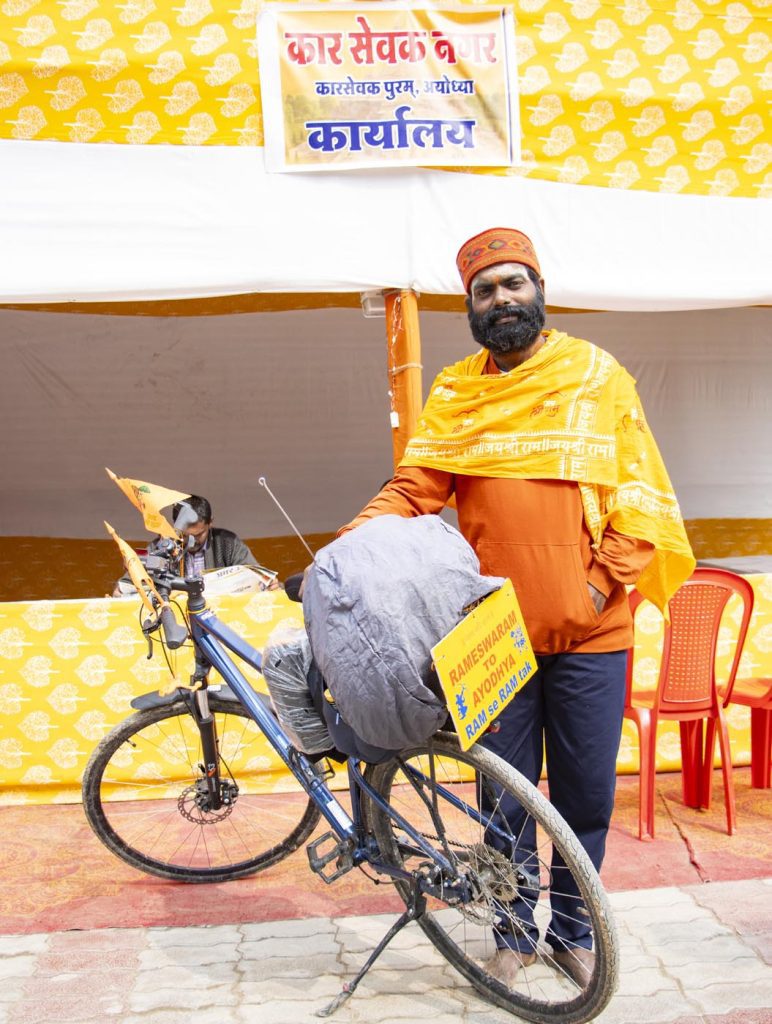

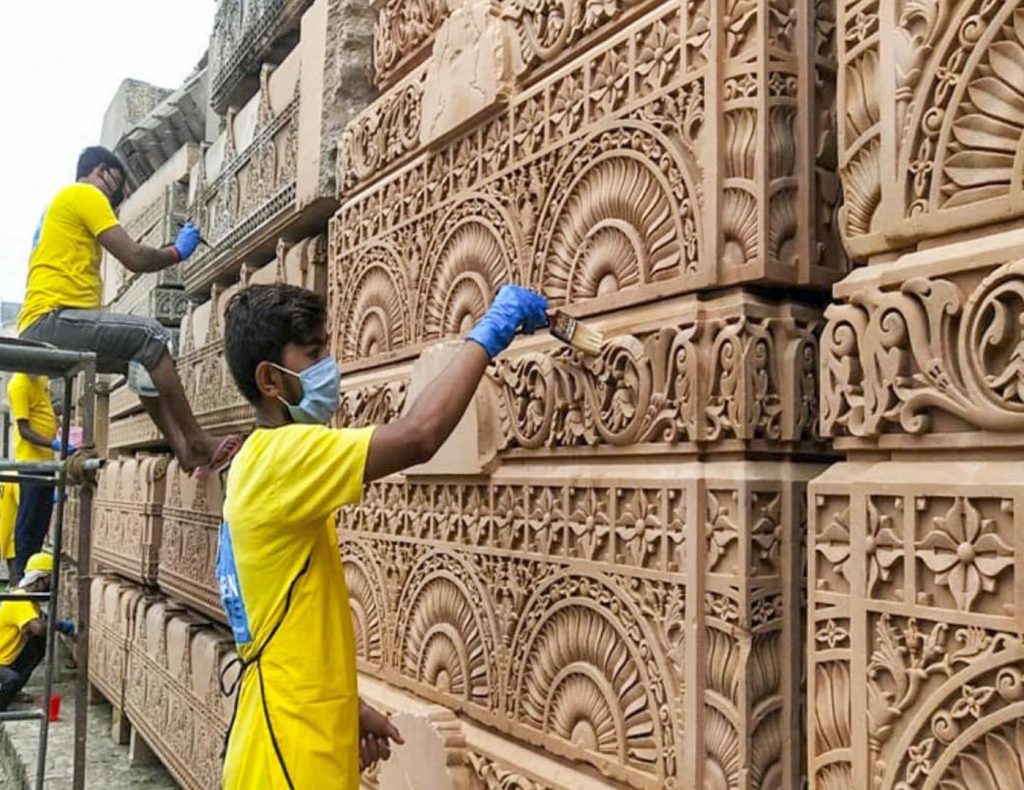

Devotees Come from Across India and Nepal


Fifteen years ago, Ashok Singhal (1926-2015), international working president of the VHP, who was in charge of the Ayodhya Ram Janmabhoomi movement, had a visionary dialogue with Larsen & Tourbro regarding the construction of the Ram Mandir, a project then estimated at us$214 million, to be paid for entirely by public donations and not government funds. As mandated by Shri Ram Janmabhoomi Teerth Kshetra Trust, L&T is constructing the temple in adherence to the traditional Indian style. In alignment with the ambitious project, renowned architect Chandrakant Sompura, who has designed and built more than 200 temples, has brought this architectural vision to fruition.
To realize this monumental masterpiece a dedicated workforce of nearly 1,200 individuals, including engineers, supervising staff and daily workers from within and beyond Ayodhya, labor in two 12-hour shifts. The new temple embodies the collective spirit and devotion of millions.
The Pilgrims
“Ram Bhaktas across the globe have converged in Ayodhya,” states Acharya Gautam. Over our five-day sojourn, we observe a steady surge in devotees. Pilgrims hailing from diverse corners of India and even Nepal flock to partake in the sacred darshan every day.
Ram Janmabhoomi Path, the main road to the temple, is adorned with a multitude of devotees spanning all of India’s religious traditions, walks of life and age groups, draped in saffron scarves symbolizing devotion to Ram, decked in their regional attire and ornaments, some complemented by traditional scarves and the revered “Sri Ram” tilaka adorning their forehead. The picturesque tableau is embellished with triangular flags bearing prints of Ram or Hanuman gracefully fluttering at shops on both sides of the road.


Along the wide road, long blessing threads dance in the wind, occasionally brushing against the faces of passersby. These are offered to God first, then worn around the wrist or neck for protection. The sweet shops, eateries, fresh juice stalls, complimentary tea and food stalls, souvenir shops, etc., are operating at full capacity. Devotees are engaged in lively haggling to acquire God posters, miniature models of Ram Mandir, and medicinal sanjivni buti grass (useful for treating dehydration). Many are marking their forehead with tilakas or indulging in moments of tranquility, sipping tea, relishing star fruit, queueing up for complimentary meals or finding repose on the road dividers. A star fruit vendor, Gautam Sonkar, says business has gone up significantly. “I am making $5 to $6 per day, enough for us to make ends meet. We are very happy.”
Devotee Narendra Vane, 75, a retired teacher from Nasik, expresses his joy: “There is no second Ayodhya in this universe, how lucky are we to witness this historic event of Prana Pratishtha.” He recollects how he came to Ayodhya in the 90s as a Karsevak—a volunteer of the VHP determined to reclaim the temple site. He asserts, “For centuries, the Babri Masjid on the spot of Shree Ram Janambhoomi was a dark stain on the name of Hindu Dharma. But now the day has come when every Hindu can walk with his head held high. It is a proud moment for all of us.”
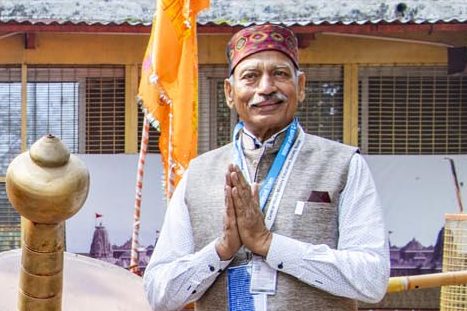

It’s a tradition that pilgrims must first pay respect to Bal Hanuman at Hanuman Garhi, then go to the Ram Temple and end the evening at the Sarayu riverbank. At dusk, Ram ki Paidi, a series of ghats along the River Sarayu, transforms at night into a radiant, floodlit spectacle as stories of Ramayana are narrated followed by videos of other important pilgrimage sites in Uttar Pradesh, such as Kashi Vishwanath.
Handling the Crowds
The priority of the Janmabhoomi Teertha Kshetra is to meticulously organize the pilgrimage experience for all devotees. There are distinct queues, security checks (twice) and facilities for depositing belongings. Saffron-clad bamboo railings up to the temple entrance demarcate the regular and fast-track queues. Notably, the fast-track is not exclusively for VIPs; it is also accessible to devotees who arrive without the possessions (cell phone, bags, etc) which must be left at the first security checkpoint. They then need only pass through the second security check.
VIPs and the disabled and elderly can enjoy the privilege of Sugam (“easy”) Darshan, obtaining free passes through online registration. After all, the presence of a VIP can itself result in chaos, and the elderly and disabled need to be accommodated. This service, operational from 7am to 9pm, provides a convenient avenue for elderly devotees and those less familiar with technology to secure passes from the temple trust office. At the Ramayana Hotel, we encounter VIPs who have made Sugam Darshan bookings, including Indian actor Pankaj Dheer, renowned for portraying the role of Karan in the Hindu epic series Mahabharata.
Dr. Sunil Kohde, a pilgrim from Nagpur, marvels at the diverse gathering of devotees in Ram Nagari, reminiscent of the inclusive realm of Lord Ram. While he appreciates the emerging spirit of equality and brotherhood among the pilgrims, he also humbly questions the need for separate queues for VIPs and commoners. Dr. Khode emphasizes, “All visitors must be treated equally. Aren’t we all equal to our Lord?”
A Nepali pilgrim from Ghaziabad (India) echoes Khode’s feelings: “The temple committee seems indifferent to the sacrifices that ordinaries like us have made over the years for the construction of the temple. As a diabetic patient, I almost fainted while standing in the scorching heat while VIPs, arriving in their AC cars, cut the line and enjoyed the privilege of darshan first.” However, her mood brightens when asked about darshan. She laughed and shared, “I forgot all my sufferings when I saw Him and continuously chanted ‘Ram Lala, Ram Lala.’ ”
We didn’t aim for Sugam Darshan but rather one of the three aarti slots: Shringar Aarti at 6:30am, Bhog Aarti at noon and Sandhya Aarti at 7:30pm. But these are fully booked for the next 15 days, with only 30-40 devotees permitted at a time.
We encounter people from Nashik, Gujarat, Karnataka, Maharastra, Kerala, Jharkhand, Assam, Manipur, Nagaland and even fellow Nepalese from the Dang district of Nepal, all pilgrimaging in big groups—100 to 1,500 at a time—making an arduous 30-hour journey on buses or trains to pay homage to God Ram. More than 200 “Aastha special trains” run by the Indian Railways after the Ram Temple consecration ceremony are seamlessly bringing pilgrims to Ayodhya from cities and towns of more than 50,000 across India.
Desikan Narayanan, a writer-columnist from Bengaluru, remembers a prior visit to Ayodhya: “We had to traverse the flooded, labyrinthine alleys of Ayodhya barefoot to reach the temple, and it broke our hearts to see our Lord in a shabby little shelter. It is a normal practice in India, when one visits a temple, to ask for one’s manokansha (wish) to be granted; but when we were visiting Shri Ram Janmabhoomi Temple in 2017, I had a feeling that we were all praying for our Ram Lala, we all wanted to see our Ram Lala back in His glory, back in His temple. Now the city has a new face and has little in common with the past.”
Pilgrim Accommodations
There are separate “tent cities” designated for luxury travelers and other pilgrims. The former receive a premium experience at a comfortable heritage stay. Those of lower economic status receive basic accommodations and meals. We visit the Panchavati facility at Karsevak Puram. Its simple buildings of galvanized tin sheets are adorned with depictions of Lord Ram’s tales on the walls. Each large room has mattresses, pillows and blankets, with separate accommodations for men and women. Meals are prepared at the Sita Rasoi kitchen twice a day, complemented by tea and snacks in the morning and evening. Once registered, a visitor has a 48-hour window to dwell in the facility.
For security, CCTV cameras are strategically placed throughout the facility. “Other facilities scattered around the city mirror the features we experience here in the Panchavati facility,” says Mohit Singh, our VHP contact. “As of now, all the facilities, catering to 25,000 devotees daily, will be operational for two months, but the duration is flexible if the growing number of devotees persists.”
Minimalist Shelters Provide Basic Accommodations
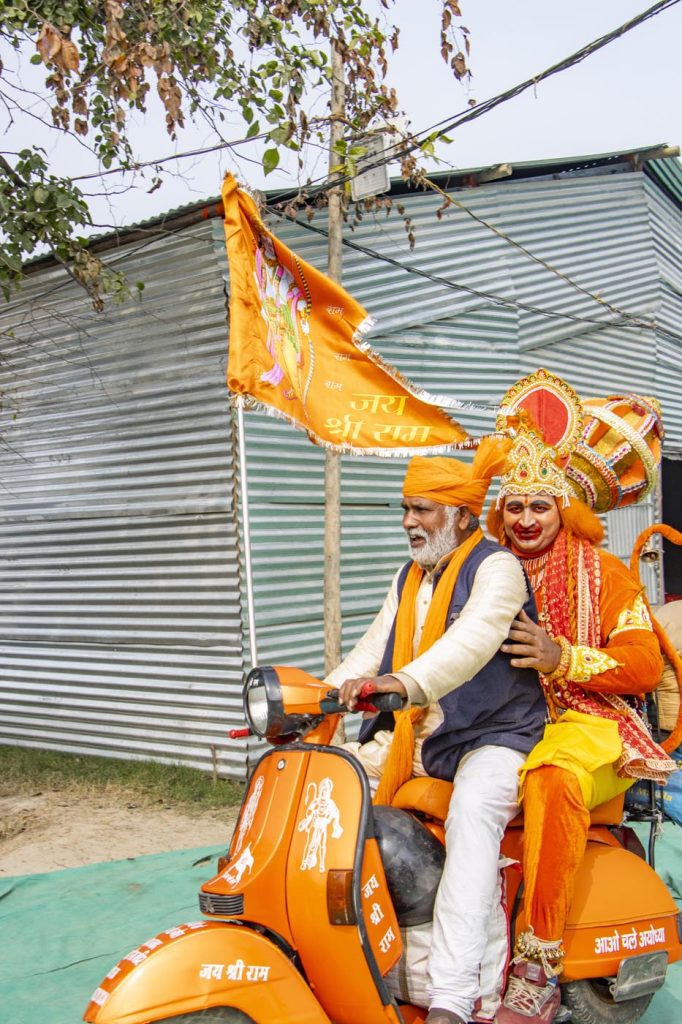

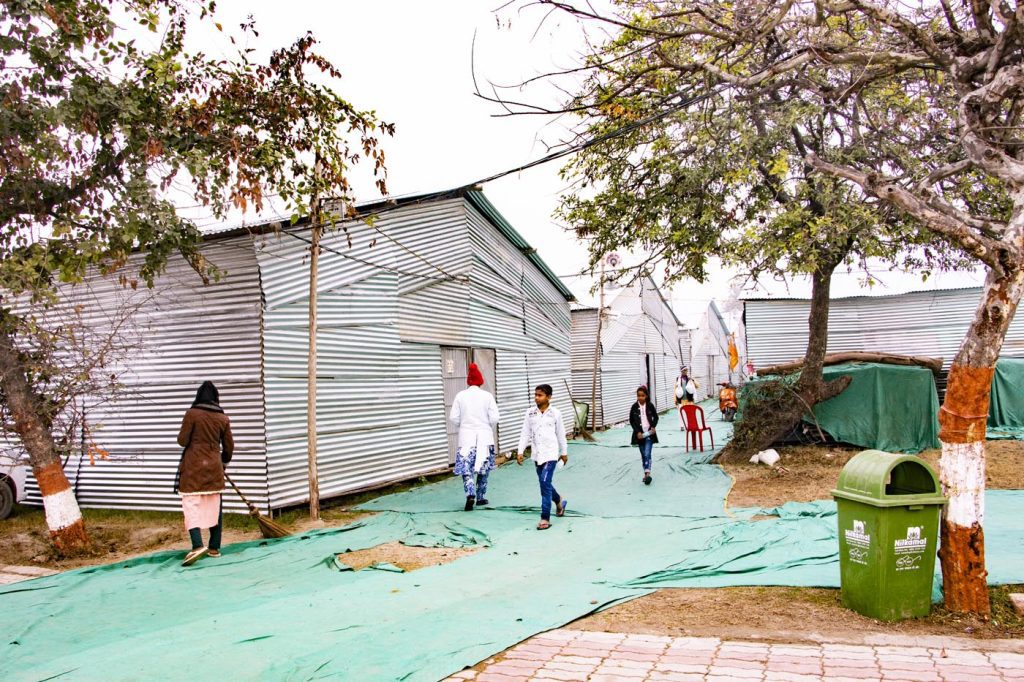

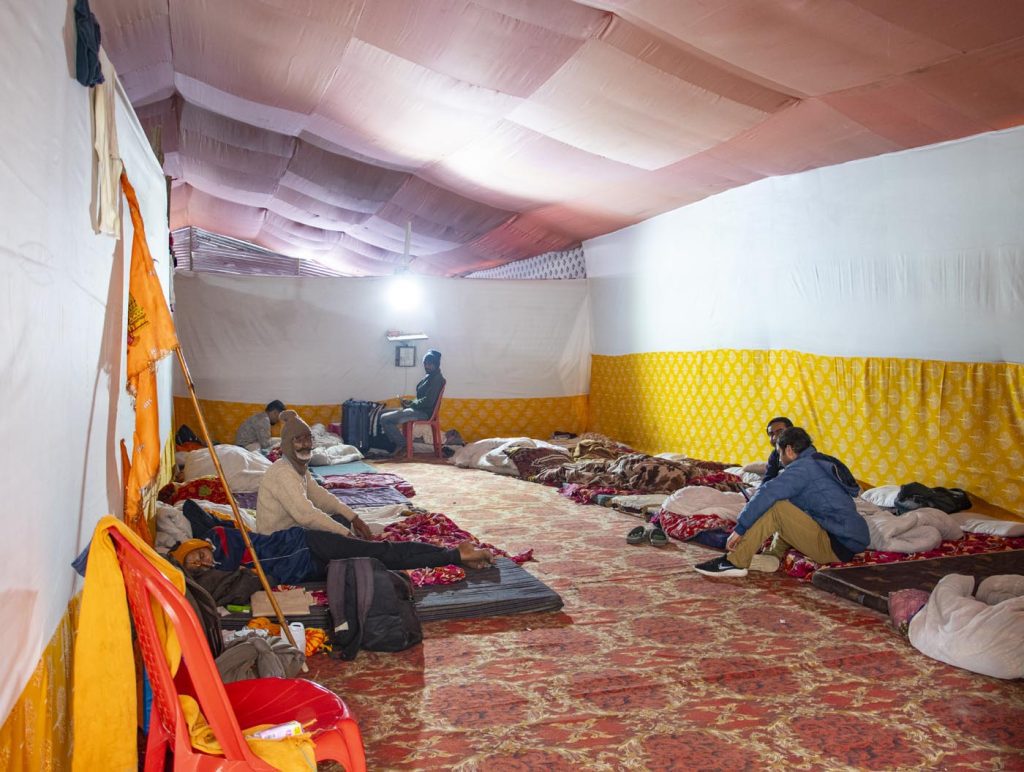

One pilgrim registering at Panchavati is Renjit C. Thalavoor, a retired army officer from Kerala, who embarked on a 25-day pilgrimage covering approximately 1,550 miles, from Rameswaram to Ayodhya, all barefoot on a cycle. He enthusiastically shares, “I commenced my yatra on the Prana Pratishtha day of Ram’s temple.” Despite just completing the journey, he seems not tired. With a cheerful grin, he shares his experiences and life values, pausing occasionally for photos upon request from other visitors. For Renjit, the journey was a joyful picnic; he was relishing meeting people en route, as he saw Ram in all of them. “Actually, I did it as a tapasya (penance), but to my surprise, it turned out to be the best journey of my life, by Lord Ram’s grace.”
Here we also meet Gomti and Kuldeep Saut, a medical duo mobilized by Sri Satya Sai Sanjeevani Hospital in Chattisgarh. The hospital has deployed around fifty staff across Ayodhya to provide first aid to patients, be it injuries or minor sickness. “The most common problems we are treating are food poisoning and dehydration,”says Gomti. Kuldeep adds, “Clearly, there are not enough stalls of drinking water in and around the temple.”
Demolition and Construction Continue at a Rapid Pace


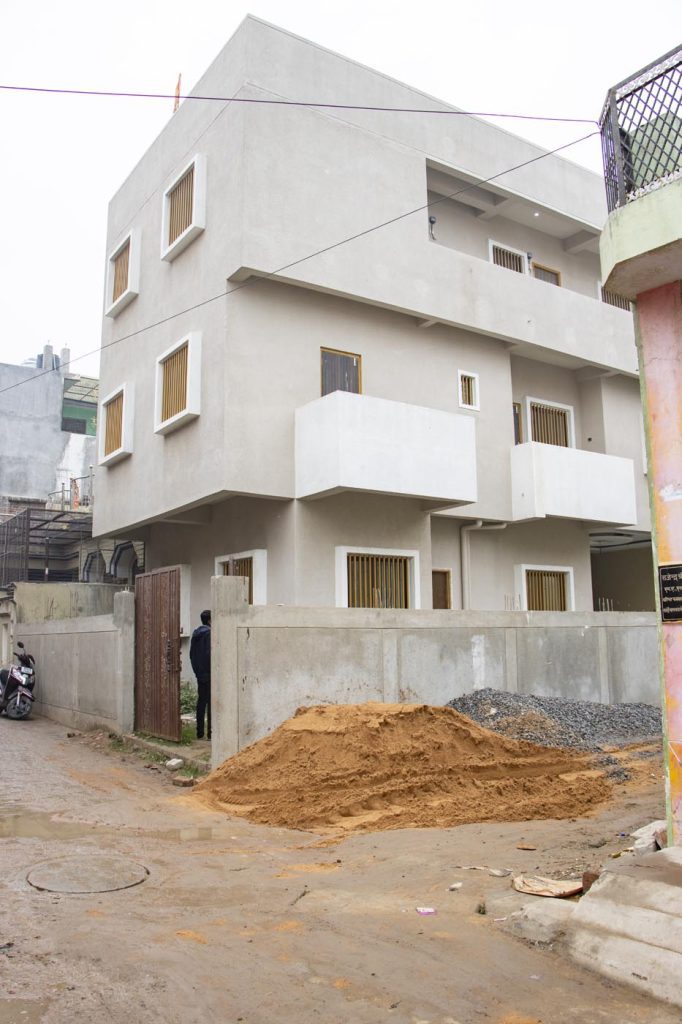

Another character we encounter is Pyare Lal, driving an orange scooter with his six-foot-tall friend dressed as God Hanuman. They had left Jharkhand with just $30. “When I went to the temple for darshan of Ram Lala, I could not stop crying. Hanuman ji kept asking me what’s wrong, but I could not stop shedding tears of joy, having seen our Lord back in His place.”
Beyond pilgrims seeking darshan, many individuals are converging here to offer selfless seva. Pilgrims from across India are distributing complimentary meals and beverages. One group is providing free meals including beans, rice, flatbread and cabbage-and-rice curry outside the community hospital at Rampath. Jahandewali Devi Mandir volunteers are offering tea and biscuits at all eight tent cities and along the Ram Janmabhoomi path. Varanasi temple associates are distributing semolina sweets each afternoon. Young boys and girls from all over the country are serving food and cleaning tables. Cooks are constantly preparing a variety of meals at Sita Rasoi. Volunteers vowing to walk barefoot during their stay are tirelessly attending pilgrims arriving and departing the tent city. Hired garbage pickers and sweepers are working diligently around the clock to maintain cleanliness in every nook and corner of the city.
The New Ayodhya
The genesis of Ayodhya’s transformation can be traced back to the land dispute involving Babri Masjid mosque, which was built in the 16th century by the Mughal emperor Babur. Hindu groups claimed the mosque was constructed on the birthplace of their God Ram. A series of legal battles and communal tensions led to the demolition of the mosque in 1992, sparking widespread riots across India which claimed 2,000 lives, mostly of Muslims. A 2019 Supreme Court ruling allowed the construction of the Ram Janmabhoomi Temple at the site.
Manoj Varma, regional head of the VHP at Karsevak Puram headquarters here told of his personal journey to this point: “This is a temple of universal significance that was under attack for centuries. I saw the day when our Ram Lala was locked up in a little shelter. I have seen police brutality and firing on people. I saw the day the Masjid was demolished in 1992. Now I have seen the day of Prana Pratishtha of Ram Lala, a matter of pride for Hindus all over the world. We will soon see a day when Ayodhya is the cultural capital of India.”
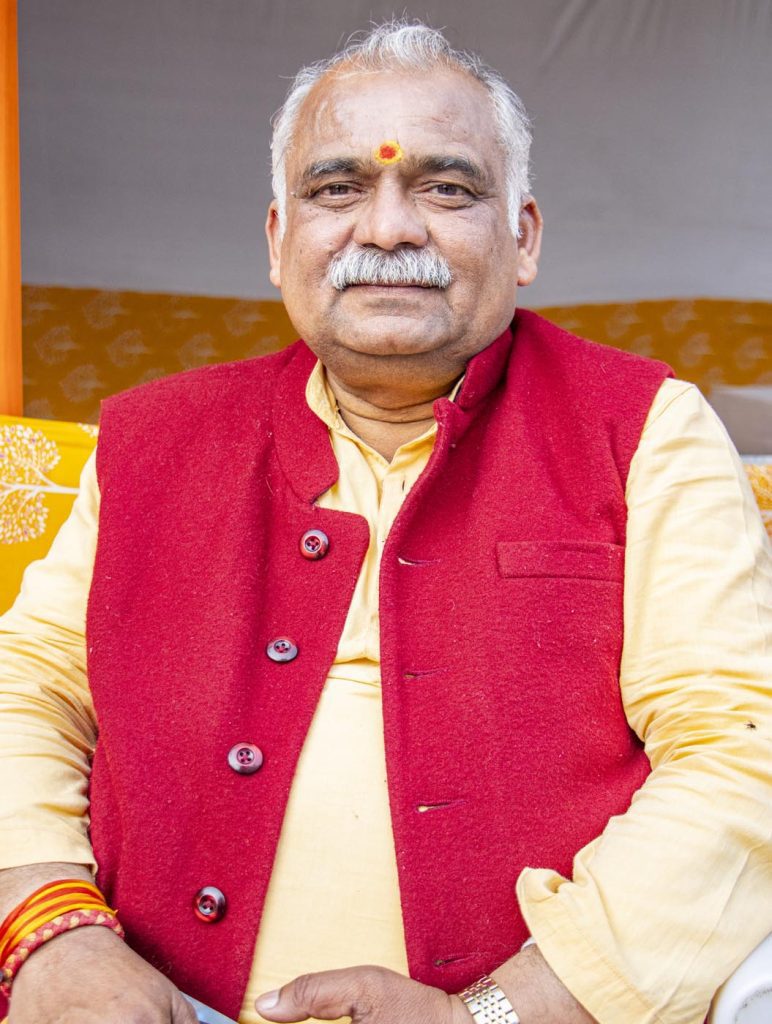

Shujaat Hussain, managing trustee of Waqf Mosque Nawab Hasan Raza Khan Chowk Faizabad, supports the Supreme Court’s decision: “To begin with, Babri Masjid was never an important mosque for Muslims in general. Most of the mosques from the Mughal era have lost their religious significance. In addition, the tenets of Islam mention that prayer cannot be offered on a disputed land. The legal restrictions on the land discouraged us from going there to pray.” Therefore, on behalf of the Muslim community, he wholeheartedly accepts the decision of the honorable Supreme Court in the Babri Masjid-Ram Mandir matter.
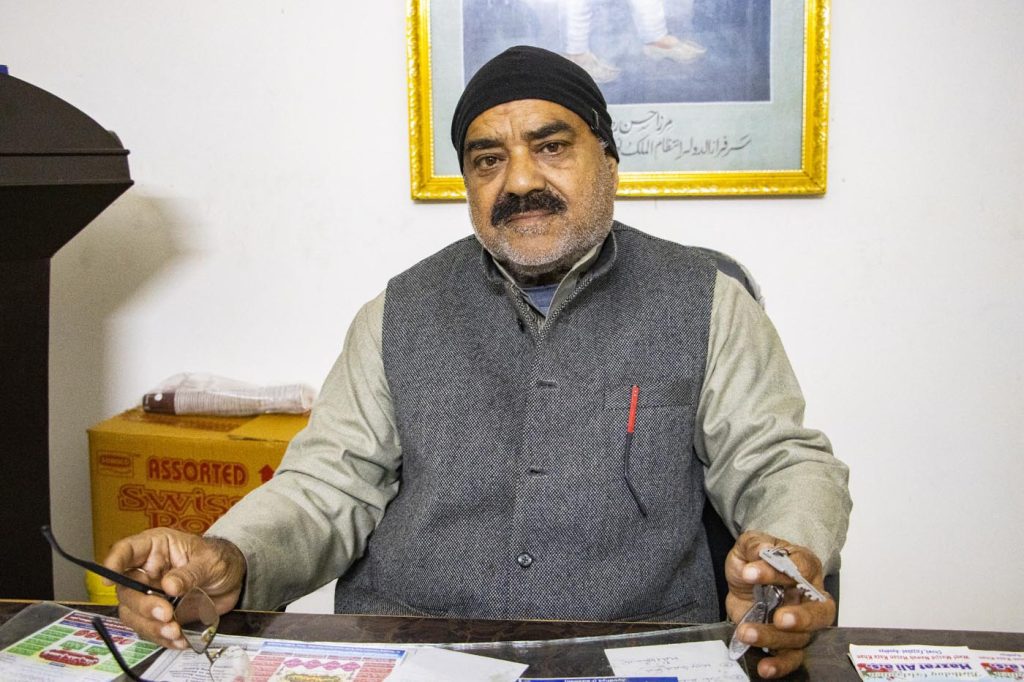

A more cynical viewpoint is expressed by Dheeraj Muktikami, a social activist from Ayodhya: “Devotion or mere politics?” He claims that Ram Mandir is a platform used by the Bharatiya Janata Party to campaign for the upcoming elections in April 2024. “It will be foolish to pretend politics have no role to play in this. All of this is a part of the political strategy and nothing else. ”
Since the Bhumi Puja in 2020, Ayodhya has bustled with frenetic construction of hotels to accommodate the tens of thousands of pilgrims. The extensive makeover, part of a $3.85 billion overhaul, is set to transform the cityscape with a new airport and a massive railway station, both modeled after the Ram temple, and expanded roads, especially crucial routes leading to the sacred site.
Ravi Prakash Sharma is a former truck driver who now navigates the streets leading to the temple on his e-rickshaw. Our driver for the next four days, Sharma said a divine boon along with Lord Ram’s return has been bestowed upon the city. Hailing from a lineage of farmers, he confidently attests to the wave of economic prosperity that has swept over his life and the entire populace of Ayodhya.
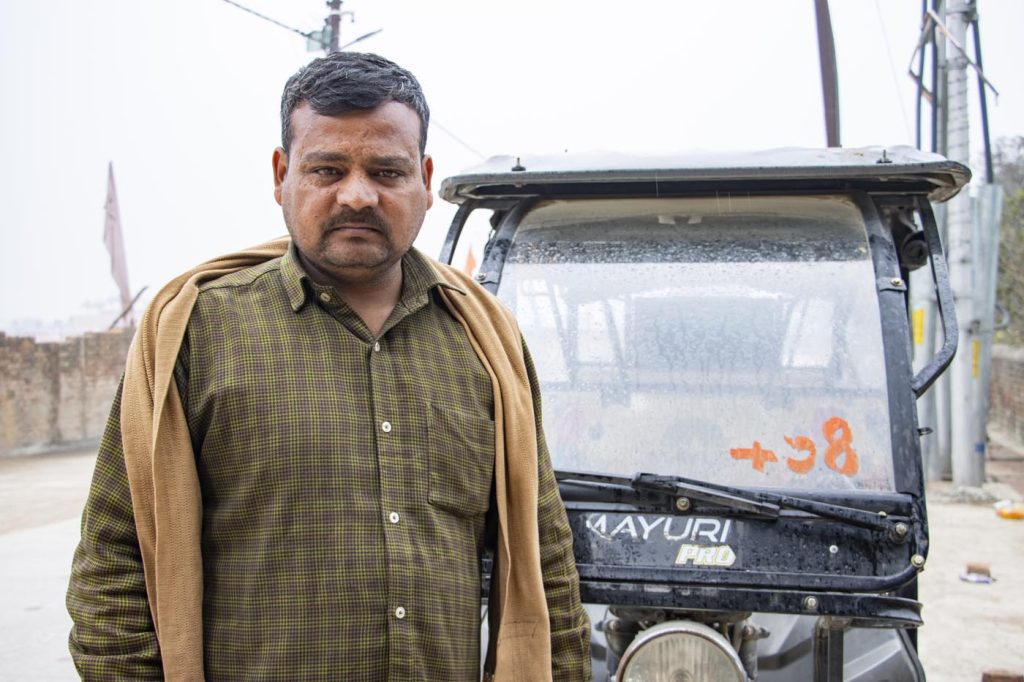

The city hums with the workers toiling tirelessly round the clock to erect infrastructures, lay sidewalks, demolish houses to make room for corridors leading to the temple, paint bridge walls, manage sewers and so on, leaving no stone unturned to ensure the city’s economic resurgence. Jai Yadav, a regular visitor for the past 10 years from Mathura, the birthplace of Lord Krishna, marvels at the city’s transformation over a mere span of two years. He says, “It’s a monumental shift in Ayodhya’s fortunes.”
Ayodhya is the city resuscitating and rising from the shadows of its past legends and glory. Its economic transformation has also triggered reverse migration as the price of land has skyrocketed. Natives are returning to start businesses or as labor workers in their hometowns. Some, like Sharma, take out a loan to buy an e-rickshaw and acquire a driver’s license to ferry pilgrims to the sacred sites.
The Price of Success
Yet, these rapid development projects have also taken a toll on the local population. Over 3,000 residences and commercial establishments have been razed, partially or completely, to make way for the pilgrims’ corridor, leaving the local community ensnared in a dichotomy of progress and loss. Rajeev and I are witnesses to a demolition spree, particularly near railway junctions. The place is a wreck. Ram Janmabhoomi Path was once wrecked, too, but was refurbished and ready just in time for the inauguration.
The displaced families in the area received a paltry compensation of about $2,400, which scarcely covered the loss of their homes. Authorities cannot comprehend that they lost not just a roof above heads or floor underneath feet, but a heritage.
Many houses here still exist in a partially demolished state. We meet a deeply disappointed Manish Gupta, 32, who is coated in dust while clearing debris from the ruins of his family home of four generations. Grievingly, he speaks extensively to Rajeev. “My father was actively involved and injured during the Karseva movement in the early 90s. He could have never envisioned that his allegiance to the cause would render his progeny homeless.” Gupta pointed at the untouched big houses across the street, arguing the demolition in the name of development permeating Ayodhya has only impacted ordinary citizens. “What kind of development is this? Who is this development for? For wealthy business houses coming from the big cities? For the people with political influence? This is certainly not for us.”
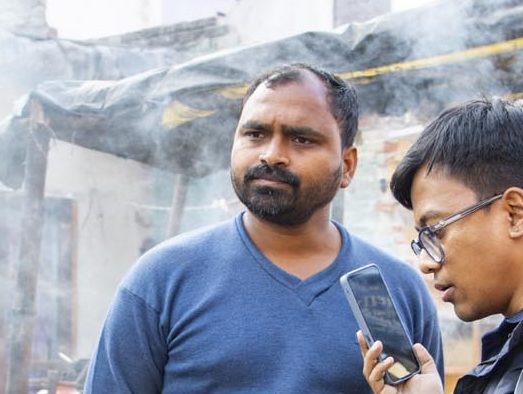

Amidst this upheaval, we meet a snack vendor selling litti chokha (stuffed wheat balls) whose stall is next to Manish’s broken house. A migrant worker from Bihar state, he says his earnings doubled over last year. His good fortune illustrates the varied impact of Ayodhya’s transformation across different strata of society.
Champat Rai envisions Ayodhya as a nexus of culture, religion and spirituality in India. He assures, “The whole world will come to Ayodhya to recharge their energy. It is the power station. For all the devotees, Ayodhya is Moksha Nagari; the city that liberates humans from the cycle of birth and death.”
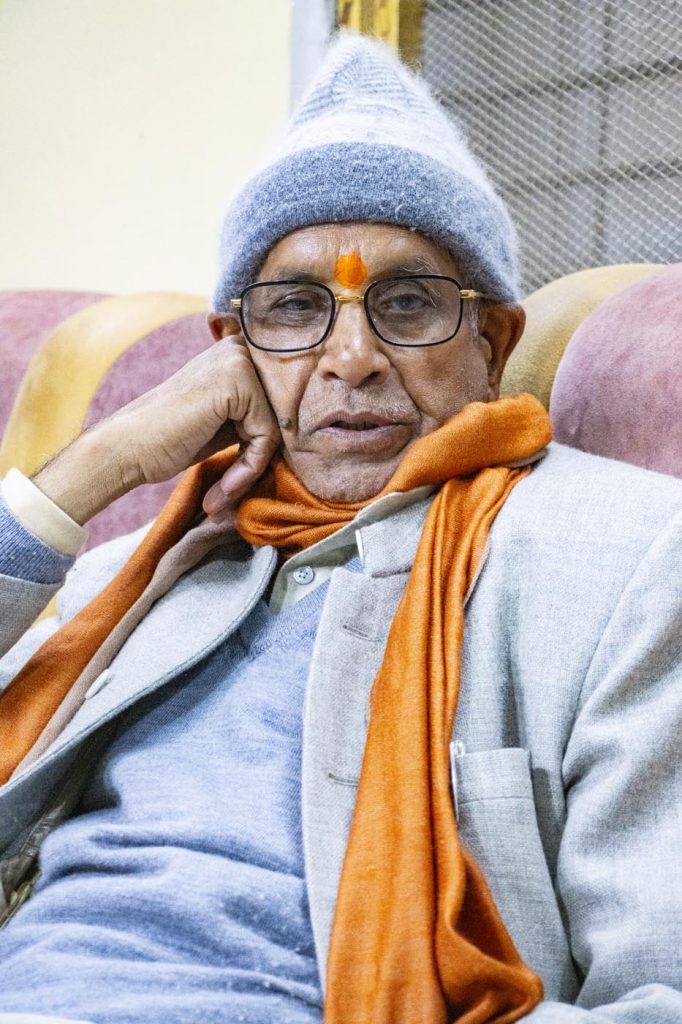

The Uttar Pradesh government’s assurance of thoughtful urban planning states a design philosophy inspired by global and domestic temple towns like Vatican City, Jerusalem, Cambodia, Tirupati and Amritsar. The team of C. P. Kukreja Architects designed the implementation strategy and the integrated infrastructure plan for the city, aiming to foster a harmonious blend of modernity and tradition. The plans incorporate sustainable practices to create a model solar city, with additional attractions around the temple such as a heritage walk, insights into Vedic civilization and the development of a wedding city.
District authorities claim that the carefully designed modern infrastructure will ensure that the developments do not compromise the historical and cultural character of the city. But this vision of national progress is marred by the sacrifices of many like Gupta, whose pleas for fairness seem lost amidst the clamor for developments.
But for many who faced unhappiness during the initial stages of redevelopment, having lost properties, their sentiments are gradually turning positive as business thrives. Sellers of flags, sweets, fruits, tea and eateries and tilaka painters express contentment. Notably, there are fewer flower sellers at Hanuman Garhi, as no flowers are allowed inside the Ram Temple. I hope there will be a return of Muslims who originally sold flowers at temples in the city. As Ayodhya strides into future development, it is imperative that its developments touch the lives of Muslims, too, as they are a community integral to Ayodhya’s cultural fabric who seem to have been sidelined in the name of development.
Ayodhya envisions itself as a global spiritual and cultural tourism destination, anticipating a daily footfall of two to three hundred thousand. Within a month of its opening, the temple has amassed impressive donations of 22 pounds of gold, 55 pounds of silver and $3 million in monetary contributions. The substantial donations underscore the transformative impact the temple will have on the city and the nation.
Ram’s Nepalese “In-Laws” Bring Gifts to Ayodhya
For the people of Janakpurdham, Nepal, Shri Ram is not just a Deity but also a cherished son-in-law who married Goddess Sita of Nepal in the Treta Yuga. The premier poet of Nepal, Shri Bhanubhakta Acharya (1814–1868), in his popular Nepalese translation of the Ramayana, sings how brilliantly Janakpur was decked in jewels, flowers and lights when Shri Ram arrived to wed Janaki (Sita), the daughter of King Janak. Thus this holy matrimony between Janakpur in Nepal and Ayodhya in India is not new. The practice of intermarriage across the border is still prevalent. This is a part of rich interwoven tapestry of cultural and socio-economic exchange, often referred to as a “Roti-Beti” relationship (“bread and daughter”—i.e., a multi-purpose marital alliance) that goes back to the Treta Yuga.
The construction of the Sri Ram Janmabhoomi Temple and consecration ceremony brought immense joy to Nepalese Hindus that matched the fervor seen in India. Janaki Mandir, the temple dedicated to Goddess Sita, was adorned with flowers in honor of the Ram Mandir consecration ceremony on January 22, 2024. The sacred place glowed with the brilliance of 125,000 oil wick lamps (picture below ), illuminating the temple precincts during a spectacular aarti dedicated to Sita-Ram. The jubilant celebrations extended to eight districts in Madhesh province bordering India, drawing thousands of devotees from nearby regions to partake in the celebration.
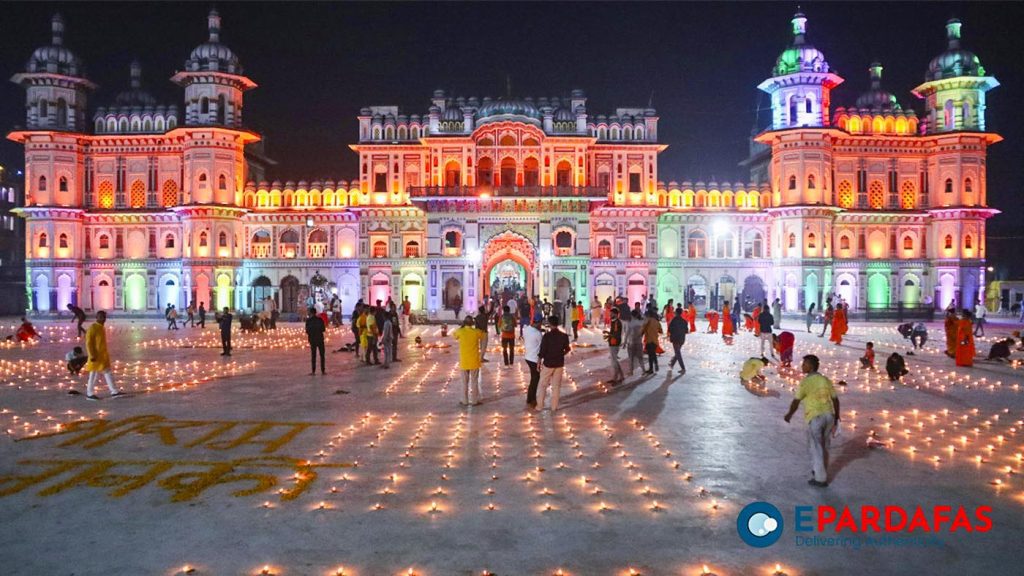

Continuing a long-standing tradition, 300 residents of Janakpurdham, Sita’s birthplace, prepared gharbasak bar, or housewarming gifts, including jewelry, utensils, clothing and sweets, arranged in specially crafted bamboo baskets—3,000 gifts in all. A 500-strong sacred procession of trucks and cars (picture below) traversed through Jaleshwarnath, Malangawa, Simraungadh, Gadhimai, Birgunj in Nepal and Betiah, Kushinagar, Siddharth Nagar and Gorakhpur of India. They arrived in Ayodhya to ceremoniously hand over the gifts to the Shri Ram Janmabhoomi Mandir Trust two weeks before the consecration ceremony.
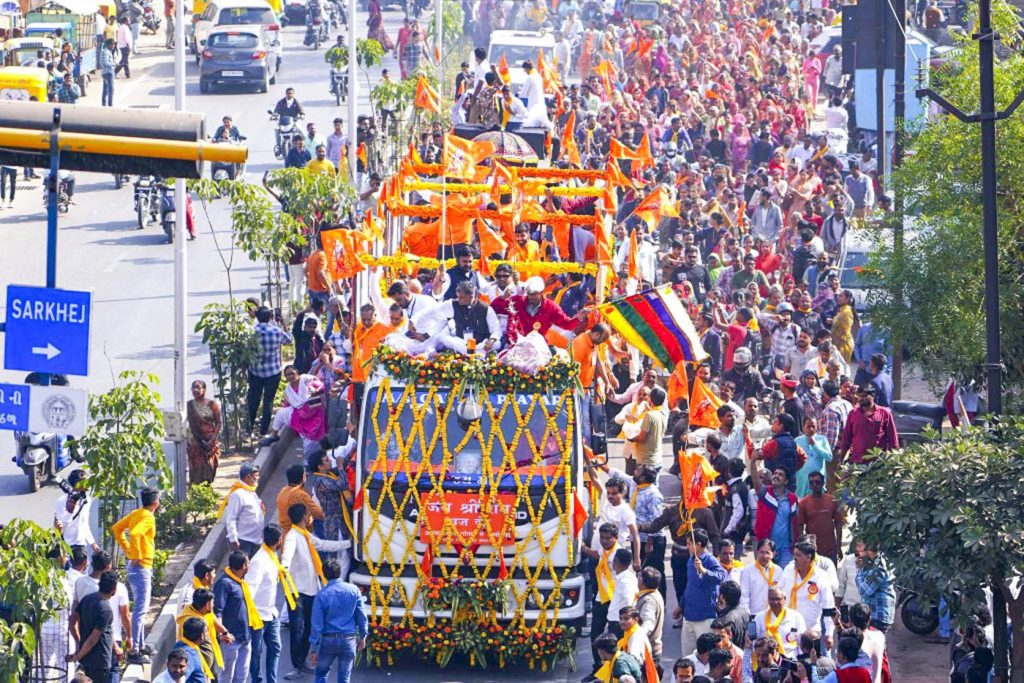

A year prior, Nepal had gifted two Shaligram boulders, 26 (picture below) and 14 tons, to Ayodhya for crafting the temple statue. Shaligram, representing Lord Vishnu’s formless Swaroop and retrieved from the riverbeds of Kali Gandaki River, holds paramount importance. The stones arrived in February 2023. Though inherently sacred, neither was found suitable for technical reasons. Consequently, the temple committee opted not to fashion a murti out of either but decided to allocate a permanent place for them within the temple vicinity once the construction is complete.

Ram’s Black Granite Murti
The 51-inch Ram Lala murti (right) is regally attired on pran prathistha day in a Banarasi dhoti and a stole, richly adorned with pure golden threads, featuring Vaishnava symbols—conch, chakra, lotus flower and peacock. He wears a jewel-encrusted gold crown, large earrings and kantha (a crescent-shaped neck piece), along with the regal lavalier studded with a large ruby kaustubha mani, the five-stranded diamond and emerald necklace called padika on His chest, and the vijaya mala or victory pendant. More jewel-encrusted ornaments include massive bangles, waistband, toe rings and gold anklets.
A tilaka embellished with diamonds and rubies marks Ram Lala’s forehead, while His feet are beautified with a lotus design, beneath which sits a gold garland. Later, silver toys including a rattle, a horse, a toy cart and a spinning top were placed before the Divine Child. Just below His feet is the original small statue of Ram. A golden umbrella crowns His nimbus, adding to the aura of divinity. Vishnu’s ten avatars, Hanuman and Garuda are carved on the black granite arch surrounding the murti. Here Prime Minister Narendra Modi and RSS head Mohan Bhagwat make official offerings on the consecration day.
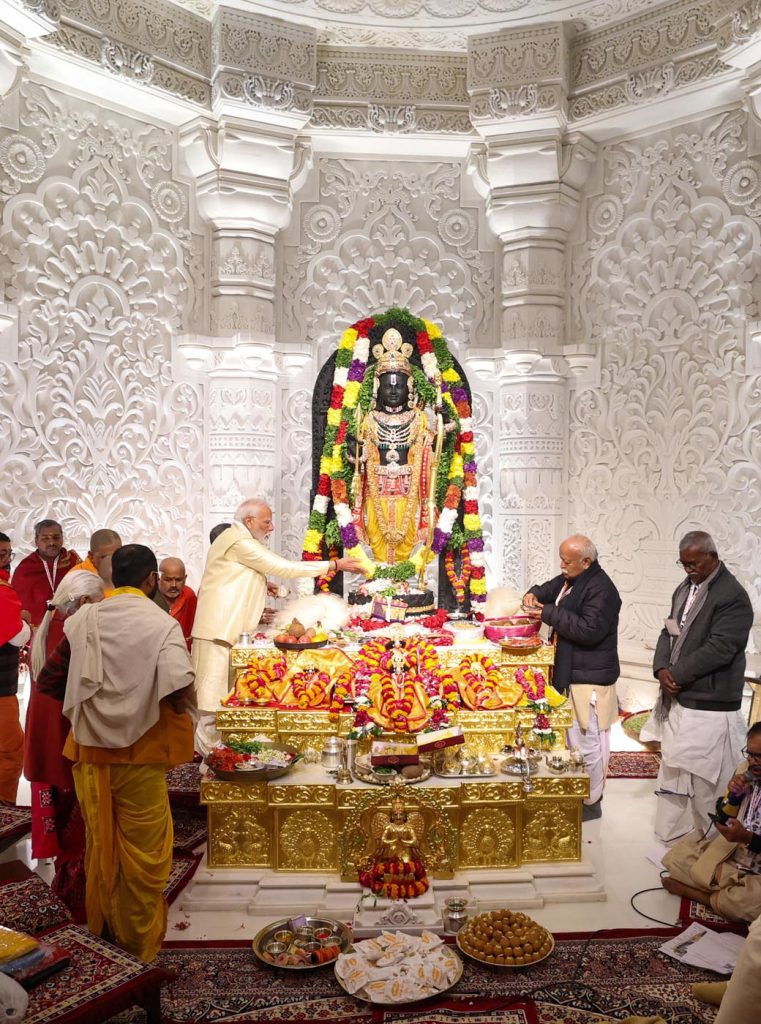

The intricate ornaments for Ram Lala were crafted by Harsahaimal Shaimal Jewelers and certified by the International Gemological Institute. They blend gold with precious stones including diamonds, rubies, emeralds and pearls, following extensive research into sacred text and under the guidance of Champat Rai, Vice-President of VHP.
The jewelry is a display of the meticulous efforts of 131 artists over 15 days to honor the Deity’s majesty. That very short time schedule was because the ornaments could only be made after the final murti had been chosen. Initially the temple trust had chosen the white marble Ram Lala by Rajasthani artist Satyanarayan Pandey, which would be typical of a North Indian temple, but at the last minute switched to this one for its durability.
Conclusion
As Hindus, Rajeev and I are deeply grateful to Hinduism Today for this opportunity to visit the temple, which has offered not just a chance for darshan but also a profound way to connect to the temple’s history, its present agendas and promises for the future.
Rajeev remarks that Ayodhya is a special place where Lord Ram manifested and continues to live, where episodes of our Lord’s life are interwoven in the narrow alleys of the city, inherent in every grain of sand in the banks of the river Sarayu. Thus the stories such as, “this is where Ram walked down with brother Lakshman, where he took ritual baths in the Ram ki Paidi,” “this is where Sita cooked meals in the Sita ki Rasoi”—we feel like they make us a part of our ithihasa, history. They make us live it in many tangible and intangible ways.
There was a yearning built up in both our hearts for many years to have a darshan of Shri Ram. This journey has made us go through a whole gamut of emotions, from seeing the reigning Deity in the sanctum to crossing paths with overwhelming numbers of Ram Bhaktas from all corners of the world.
Sri Rama Rama Rameti, Rame Raame Manorame means, “By meditating on the name of Rama, my mind gets absorbed in the divine consciousness of Rama, which is transcendental.”
In Ayodhya, we have discovered the joy of chanting “Sri Rama Namam” that fills our heart with love and devotion. The echoes of a full throated “Jai Shri Ram,” make our hair stand on end, make us want to surrender ourselves to Him and transpose us to another world, a world of our Lord.
We are eagerly looking forward to the moment we can witness the temple in all its completed glory. However, what holds greater significance for me is the principle of inclusivity, the Ram Rajya, kingdom of Ram, that Mahatma Gandhi imagined—where everyone living in Ayodhya, regardless of caste or creed, stands to benefit from the remarkable transformations that the Shri Ram Janmabhoomi Temple brings into their lives.
About The Author


Nikki Thapa is a photographer and image editor. Her website, askmeaboutnepal.com, is a rich resource on Nepal’s culture and traditions. nikkithapa@gmail.com.


